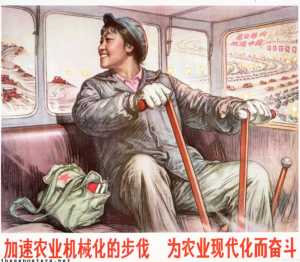
Designer: Liu Wenxi (刘文 西)1975, December
Publisher: Renmin meishu chubanshe (人民美术出版社)
Throughout Mao’s rule in China, he aimed for uniformity and unification throughout the nation. He believed in creating a unified body where individuality was not valued, but rather a group mentality in which his own philosophies and beliefs were the exercised norms. He utilized propaganda, such as this, to encourage people of all genders to contribute to the economy, regardless of their abilities or desires.
The woman: or the female subject This propaganda immediately draws the viewers’ eyes to the woman working heavy machinery, looking very happy. Although it is possible to tell that she is, in fact, a woman, she has very masculine features and her hair is pulled back in the cap. The woman is therefore, stripped of her femininity in order to be most productive in the workplace. This prioritization of male over female features indicates a pro-masculine theory that Mao supported and encouraged. Although this uniform is supposed to be gender neutral, it masculinizes the female, rather than feminizing the male, consequently, leaving the male the same and changing the woman. This woman was also placed into a field of work in which she biologically is less capable than men. By nature, men are stronger and can handle heavier equipment better than women. By placing a woman into this same exact workplace as a man, she is immediately at a disadvantage trying to keep up and having to work much harder to do the same labor that a man can do with less difficulty, therefore creating inequality in the workplace.
The little red book: The woman in this book has a little red book sitting next to her in her bag. Mao required everyone to carry around his little red book which was all that was learned in schools and taught to children. Growing up on only his philosophies, the people of China were, in a way, brainwashed by his thought. The carrying of the book was enforced, ultimately imposing his philosophies onto everyone so that everyone thought the same way, just as they dressed the same way. Intellectuals were discriminated against as they did not always follow Mao’s theories, and being a part of the working class was viewed as ideal.
the little red book as political rhetoric or education as well as visual element, due to its size and color
The vehicle in which the woman is driving: The woman, herself, appears to be enjoying her time in the vehicle, alone. She is smiling and by herself, and the viewer is able to see her identity and emotions. However, Mao discouraged against individuality and, rather, desired uniformity and homogenous unity. Because this propaganda appears to show that Mao was concerned with individual wellbeing and happiness, the viewer desires this type of work. It is important to recognize though, that this woman’s individuality is not valued. She is wearing the same thing as everyone else working there, and the viewer can see that there are hundreds of other people working at the same place in the background. This propaganda was well thought out in order to promote hard labor to improve the economy, but the vehicle is representative of the woman being only a working part of the internal machine, not the sole operator. machine is the focus but the paragraph seems bit off the focus.
good work, but the organization could be easily revised into: 1) the claim — the female subject/body as the masculinized 2) support the claim in terms of the uniform, the machine, the little red book, and the landscape (titled as modernization of agriculture)
